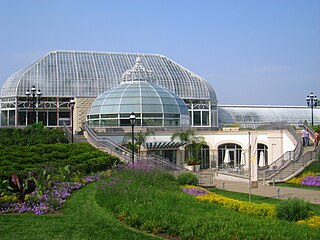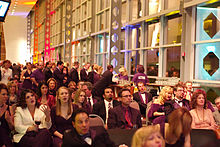
Pittsburgh is a city in the Commonwealth of Pennsylvania and the county seat of Allegheny County. It is the most populous city in both Allegheny County and Western Pennsylvania, the second-most populous city in Pennsylvania after Philadelphia, and the 68th-most populous city in the U.S. with a population of 302,971 as of the 2020 census. It is the largest city of the Greater Pittsburgh metropolitan area of Western Pennsylvania; its population of 2.457 million is the largest in both the Ohio Valley and Appalachia, the second-largest in Pennsylvania, and the 26th-largest in the U.S. It is the principal city of the greater Pittsburgh–Weirton–Steubenvillle combined statistical area that extends into Ohio and West Virginia.
Hollywood North is a colloquialism used to describe film production industries and/or film locations north of its namesake, Hollywood, California. The term has been applied principally to the film industry in Canada, specifically to the cities of Toronto and Vancouver.

A short film is any motion picture that is short enough in running time not to be considered a feature film. The Academy of Motion Picture Arts and Sciences defines a short film as "an original motion picture that has a running time of 40 minutes or less, including all credits". In the United States, short films were generally termed short subjects from the 1920s into the 1970s when confined to two 35 mm reels or less, and featurettes for a film of three or four reels. "Short" was an abbreviation for either term.

The film industry or motion picture industry comprises the technological and commercial institutions of filmmaking, i.e., film production companies, film studios, cinematography, animation, film production, screenwriting, pre-production, post-production, film festivals, distribution, and actors. Though the expense involved in making films almost immediately led film production to concentrate under the auspices of standing production companies, advances in affordable filmmaking equipment, as well as an expansion of opportunities to acquire investment capital from outside the film industry itself, have allowed independent film production to evolve.
Filmmaking or film production is the process by which a motion picture is produced. Filmmaking involves a number of complex and discrete stages, starting with an initial story, idea, or commission. It then continues through screenwriting, casting, pre-production, shooting, sound recording, post-production, and screening the finished product before an audience that may result in a film release and an exhibition. Filmmaking occurs in a variety of economic, social, and political contexts around the world. It uses a variety of technologies and cinematic techniques.

In the performing arts industry such as theatre, film, or television, casting, or a casting call, is a pre-production process for selecting a certain type of actor, dancer, singer, or extra for a particular role or part in a script, screenplay, or teleplay. This process may be used for a motion picture, television program, documentary film, music video, play, or advertisement, intended for an audience.

Antoine Fuqua is an American film director known for his work in the action and thriller genres. He was originally known as a director of music videos, and made his film debut in 1998 with The Replacement Killers. His critical breakthrough was the 2001 crime thriller Training Day.

Cinema of the Netherlands refers to the film industry based in the Netherlands. Because the Dutch film industry is relatively small, and there is little or no international market for Dutch films, almost all films rely on state funding. This funding can be achieved through several sources, for instance through the Netherlands Film Fund or the public broadcast networks. In recent years the Dutch Government has established several tax shelters for private investments in Dutch films.

The Cinema of the Philippines began with the introduction of the first moving pictures to the country on August 31, 1897, at the Salón de Pertierra in Manila. The following year, local scenes were shot on film for the first time by a Spaniard, Antonio Ramos, using the Lumiere Cinematograph. While most early filmmakers and producers in the country were mostly wealthy enterprising foreigners and expatriates, on September 12, 1919, Dalagang Bukid , a movie based on a popular musical play, was the first movie made and shown by Filipino filmmaker José Nepomuceno. Dubbed as the "Father of Philippine Cinema," his work marked the start of cinema as an art form in the Philippines.
Film finance is an aspect of film production that occurs during the development stage prior to pre-production, and is concerned with determining the potential value of a proposed film.
The Culture of Pittsburgh stems from the city's long history as a center for cultural philanthropy, as well as its rich ethnic traditions. In the 19th and 20th centuries, wealthy businessmen such as Andrew Carnegie, Henry J. Heinz, Henry Clay Frick, and nonprofit organizations such as the Carnegie Foundation donated millions of dollars to create educational and cultural institutions.
The Cultural District is a fourteen-square block area in Downtown Pittsburgh, USA bordered by the Allegheny River on the north, Tenth Street on the east, Stanwix Street on the west, and Liberty Avenue on the south.

Hollywood East is a term for the multiple efforts to build film industry agglomerations on the East Coast of the United States. Recently, the term has been applied to the growing film industry in New England, particularly in Massachusetts and Connecticut, that served as home to the production of over 140 major motion pictures and television series between 2000 and 2013. It is a reference to Hollywood, California, the center of the American film industry, located on the west coast of the United States. The term as used in New England was popularized in the press in 2007 as film and television productions migrated to the east coast to take advantage of the region's scenery, culture, character, and tax incentives put in place by several state governments.
Runaway production is a term used by the American Hollywood industry to describe filmmaking and television productions that are intended for initial release/exhibition or television broadcast in the U.S., but are actually filmed outside of the immediate Los Angeles area, whether in another country, another U.S. state, or in another part of California.
Fís Éireann / Screen Ireland, formerly known as Bord Scannán na hÉireann / the Irish Film Board, is the Republic of Ireland's state development agency for the Irish film, television and animation industry. It provides funds for the development, production and distribution of feature films, feature documentaries, short films, TV animation series and TV drama series.
The Pennsylvania Film Production Tax Credit is a tax credit program supporting the production of feature films and television programs in Pennsylvania. The tax credit was signed into law by Gov. Ed Rendell in July 2004.
The California Film Commission (CFC) was founded in 1985 by then California Governor George Deukmejian to act in an economic development capacity for the state. It is a part of the California Trade and Commerce Agency, formerly the Business, Transportation, and Housing Agency. Its purpose is to enhance California's position as the location of choice for motion picture, television and commercial production.

Movie production incentives are tax benefits offered on a state-by-state basis throughout the United States to encourage in-state film production. Since the 1990s, states have offered increasingly competitive incentives to lure productions away from other states. The structure, type, and size of the incentives vary from state to state. Many include tax credits and exemptions, and other incentive packages include cash grants, fee-free locations, or other perks.

The Virginia Film Office is a part of the Virginia Tourism Corporation located in Richmond, Virginia. The Virginia Film Office brings jobs and revenue to the Commonwealth by marketing the state as a location for film, television, and commercial production and by supporting and fostering Virginia's in-state production industry.
The film industry in Georgia is the largest among the states of the United States for production of feature films by number of films produced, as of 2016. Atlanta is the center of the film industry in Georgia with Turner, Tyler Perry, and EUE/Screen Gems studios located there.













